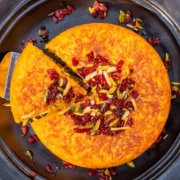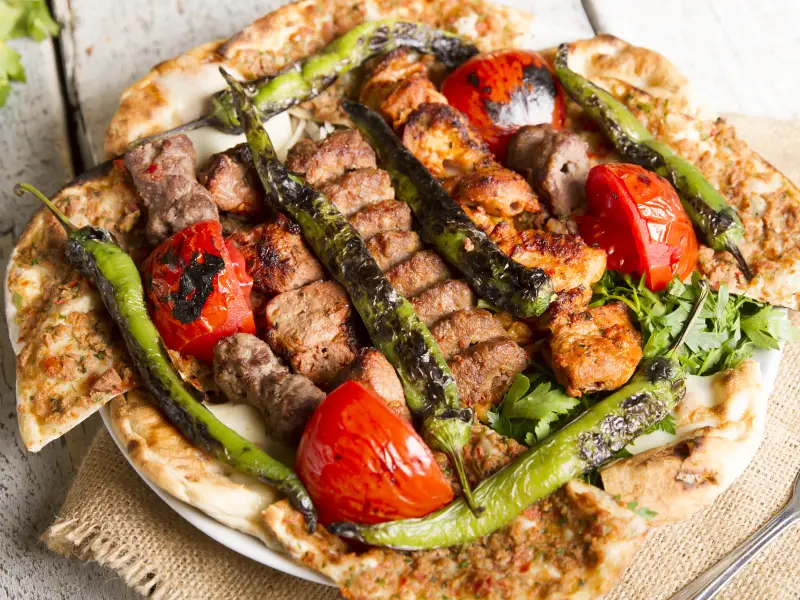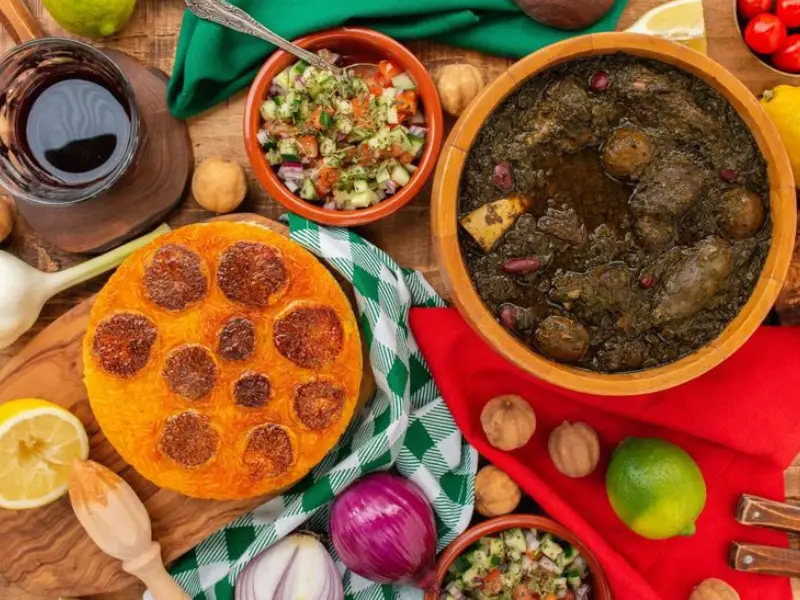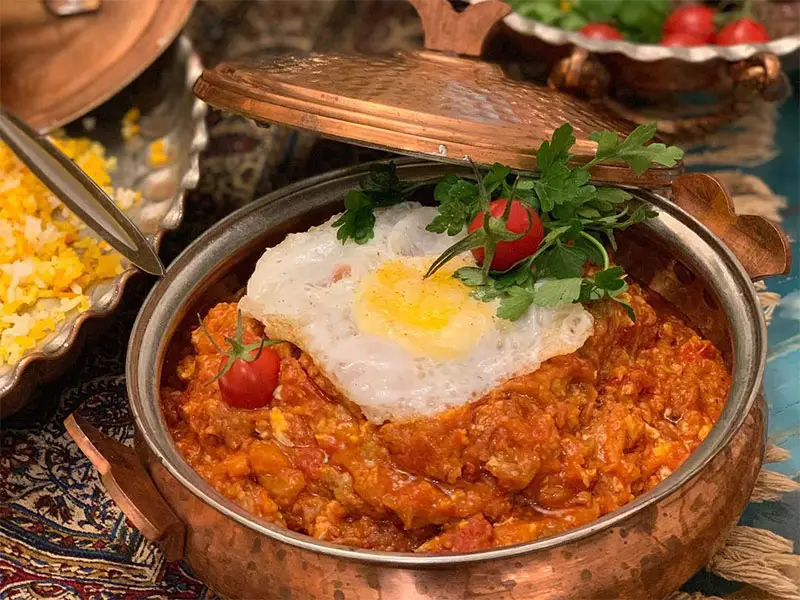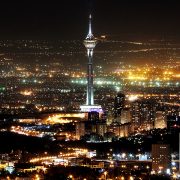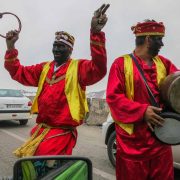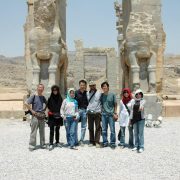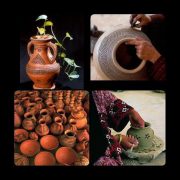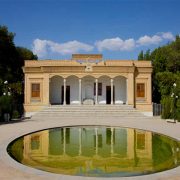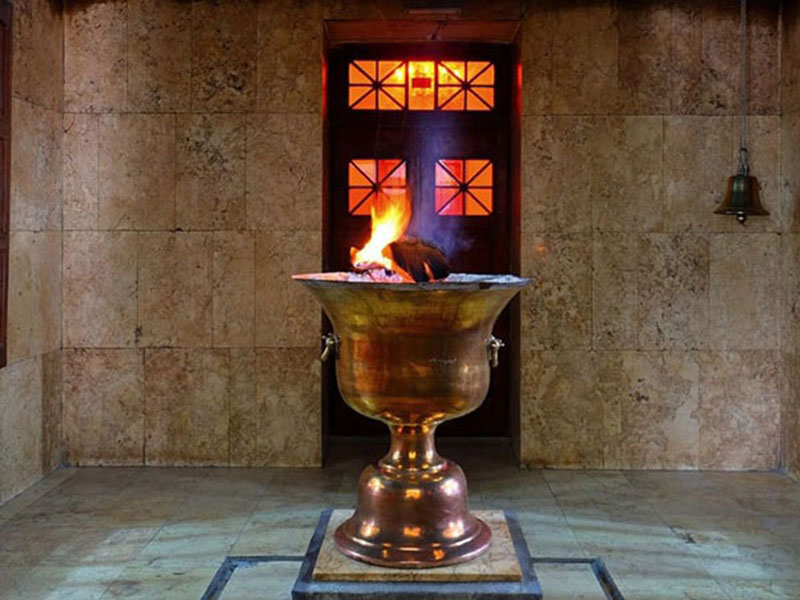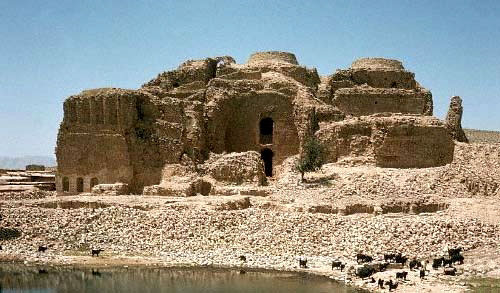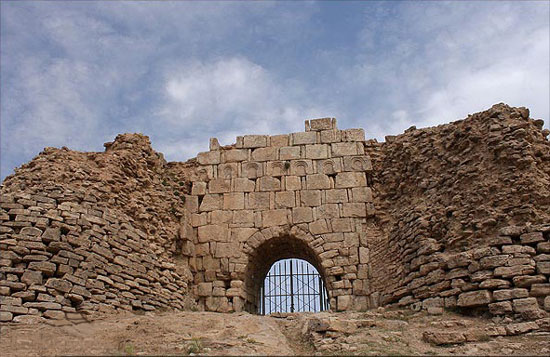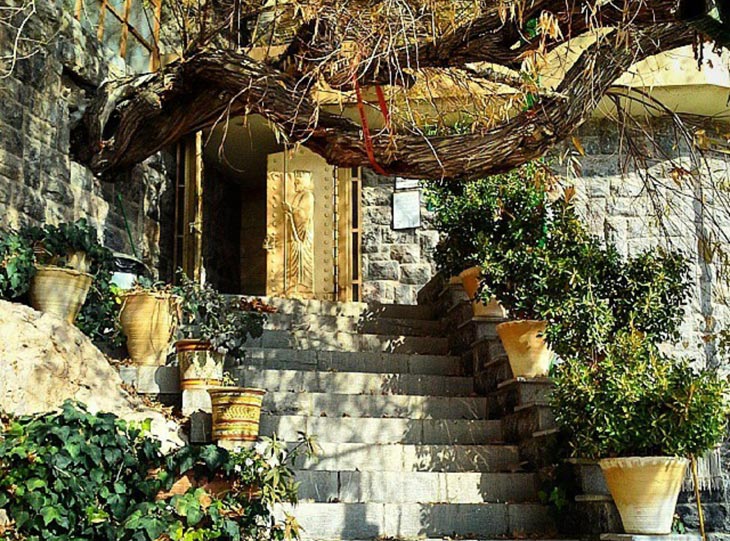Travel to Iran would probably be like none of your previous trips, it is certainly a unique destination you never expect. There are loads of unique experiences waiting for you here, including cultural attractions, natural beauty, warm-hearted hospitable people, and tasty local foods.
Well, the next issue might be your safety. While you are searching is it safe to travel to Iran, it is never easy to distinguish between propaganda and genuine information. The two risk assessment institutions “International SOS” and “Risk control” evaluate Iran’s risk to travelers to be comparable to that of most European countries’.
Iran Doostan Tours Co. is a reliable Iran travel agency for incoming tours to Iran. No difference whether you are aiming to travel to Iran from Canada or travel to Iran from India, or any other country, we are honored to offer high-quality services in terms of diverse package tours. As a tour operator and travel agency in Iran, we provide all travel services including itineraries, visa, tour guides, transportation, accommodation, and whatever our tourists may need while traveling to Iran. If you are looking for some self-drive tours like travel to Iran by car, we are also ready to provide you with all you may need.
It is good to know that the Iran visa process is quite fast and convenient and the tourists can also apply for a visa online. However, if you intend to travel to Iran from the UK or US, your visa may take a bit longer to be issued.
If you have a call for an independent traveling to Iran, we wholeheartedly respect your decision; then all you may need to have except an Iran travel guide book and a map would be reading some tips for traveling to Iran in our Iran travel blog. For any travel to Iran experience, you are recommended to visit our guest blog and also our trip advisor page, it may be helpful. You may also like to spare some time watching interesting Iran tourism videos to whet your appetite for traveling to Iran.
Our professional colleagues are ready to help you if you have planned to travel to our country. Contact us via info@idt.ir. We will be back to you soon.
Posts
Top 6 Iranian food: So Tasty But Not Too Spicy
Iran, as a large country embracing different ethnicity with different cultures, is so diverse in culinary that every city enjoys a large variety of delicious foods unique to that area. Iranians love spices and use various seasonings for their food. Such as turmeric, saffron, black pepper, dried lemon, cumin, and so forth give a savory smell to the foods and make them delicious. Iranians use a lot of spice, but Persian food is usually tasty, not necessarily spicy. Iranian foods are a mixture of the most nutritious ingredients, including meat, rice, vegetables, beans, and spices. Iranians mix all those ingredients in such a balance that they turn into a delicious and nutritious meal. Kebabs, stews, and different kinds of rice (Chelow and Polo) are well-known Persian dishes.
Is Iranian Food Spicy?
Indeed, you can’t deny Iranians’ love for spices. They love using various kinds of seasonings to give their meal a mouthwatering smell and taste. In most Persian foods, Iranians use Saffron either as a garnish or for a better taste and aroma. Different spices are used in various dishes based on personal preferences, so Iranian food cannot be definitively defined as spicy. If you travel to Iran, you have the chance to experience making great Persian foods in major cities of Iran or the heart of nature. You can learn more about Iranian cuisine by reading our guest blog, which includes a foodie’s take on Persian cuisine in Iran. And finally, here are some of the most delicious and best Iranian foods introduced as follows:
Kebabs
Iranians love kebabs and enjoy the tasty flavor and smell of various kinds of kebabs, such as Joojeh Kebab and Kebab Koobideh. Joojeh Kebab (Chicken kebab), the Iranian favorite picnic food, is a very delicious meal, especially when made with fresh chicken marinated in yogurt, saffron, and lemon juice. Iranians are an expert at making Joojeh Kebab with boneless chicken breast cut into small pieces. Iranians usually grill Joojeh Kebab over hot coals when they go on a picnic and serve it with grilled tomatoes, onions, peppers, or rice.
Kebab Koobideh is also the most famous of all kebabs in Iran. Grilling Kebab Koobideh gives off an outstandingly delicious smell. Usually made from ground lamb or beef with chopped onion, Kebab Koobideh is a tasty dish that Iranians serve at formal ceremonies and during friendly picnics.
Gheymeh Nesar
Gheymeh Nesar of Qazvin is an incredibly delicious Persian jeweled rice with succulent pieces of lamb. The taste of rice, mixed with Persian barberries, pistachio, cinnamon, turmeric, rose water, and saffron, and garnished with orange pill slices and almond silvers, is heavenly tasty. Eating Gheymeh Nesar after visiting the historical attractions of Qazvin would be one of the most pleasant moments of your travel to Iran. There is no better place to taste this traditional Persian food than the friendly local houses of Qazvin in north-central Iran.
Ghormeh Sabzi
This is something special! You may have already heard about this famous Iranian food. Ghormeh Sabzi (Persian herb stew) is one of the most beloved stews among Iranians. You would rarely find someone who does not love Ghormeh Sabzi. A combination of different aromatic herbs, cooked lamb cubes, beans, and dried lemons make it very delicious. Iranians serve Ghormeh Sabzi alongside cooked rice (Chelo). Traditionally, Persian families serve Ghormeh Sabzi as the main dish in every household gathering. It somehow represents the love of the host towards its guests. If you were invited into a Persian household and they served you Ghormeh Sabzi, then you know! Make sure you don’t miss it on your trip to Iran.
The Northern cities of Iran have a variety of very delicious foods. Rasht and Deylaman are two of the northern cities of Iran offering various delicious foods such as Fesenjan, Mirza Ghasemi, and Baghali Ghatogh to tourists and travelers. Once traveling to the North of Iran, you will have the opportunity to enjoy making and eating such scrumptious meals.
Fesenjan
Fesenjan (Persian pomegranate and walnut stew) is a tasty stew integrated with Iranian culture. The ingredients are well-ground walnut, pomegranate sauce, and slow-cooked chicken or duck pieces. Iranians cook Fesenjan at a low temperature to let the tastes blend and release walnut oil on the stew. The well-mixed ingredients make a sweet and sour taste that is appetizing. Similarly to many other Persian stews, Iranians also serve Fesenjan with rice (Polo or Chelow). Fesenjan, as an Iranian cuisine, is considered a luxury dish often served during Persian wedding ceremonies. If you ever get an invitation to an Iranian wedding party, you can taste this luscious fare.
Mirza Ghasemi
In order to make this delicious dish, Iranians grill the eggplants until the skin is charred and peeled off. Then, they add a lot of garlic, tomatoes, salt, and pepper to the grilled eggplants. For the final step, eggs are mixed with the ingredients to give the dish an excellent taste. Locals of the northern part of Iran serve Mirza Ghasermi as an appetizer, side dish, or the main dish, with Persian bread or rice. Since it is a simple meal by only grilling the eggplants on fire, you can easily make such a delicious meal once you enjoy being in the forests of Gilan.
Baghali Ghatogh
Baghali Ghatogh is an easy, healthy, and tasty Persian dish, one of the most popular northern Iranian dishes. It is one of the quickest dishes getting ready in less than an hour. Baghali Ghatogh is also a vegetarian dish, including aromatic dills, garlic, fresh beans, eggs, salt, and pepper. Iranians serve Baghali Ghatogh with bread or rice. If you ever take a trip to the northern region of Iran, make sure to taste this delicious traditional Persian food.
Are you planning to travel to Iran? Check out our Iran food tour.
Iranian festivals and ceremonies as tourist attractions
Festivals, rituals, events, and traditions are among the variety of interesting factors that make a distinction. The distinction is a critical factor motivating tourists to travel around the globe. In addition to its historical importance, Iran has a variety of ancient traditions still practiced by its people. Here are some of the most famous Iranian festivals and ceremonies explained in detail to help you get familiar with Iranian culture. If you are planning to visit Iran, here is the link to Iran online visa form.
Chaharshanbeh Suri
Chaharshanbe Suri, known as the Festival of Fire, is one of the Iranian festivals celebrated on the eve of the last Wednesday before Nowruz. The origin of the festival dates back to the early Zoroastrian era. This festival is celebrated with fireworks displays and jumping over fires. People gather by the fire, jump over it, and they say to the fire, “Give me your beautiful red color and take my sickly pallor!” People believe that the red color of fire symbolizes health. Iranians perform a variety of traditions on this night. Nearly every city in Iran has a custom of jumping over a fire and buying sweet and sour nuts. It is believed that eating nuts will make your wishes come true at Chaharshanbe Suri Festival. Ash Reshteh, a Persian stew, is a tradition that makes this festival astonishing.
Nowruz
As the start of the New Year, Nowruz is one of the most celebrated Iranian festivals worldwide among Iranians and other ethnolinguistic groups. Persian New Year begins at the end of the freezing days of winter when the fresh mild days of spring are celebrated for 13 days, starting on March 21, the first day of spring in Iranian calendars. Since Nowruz begins at the exact moment of the vernal equinox, the moment of celebrating the New Year differs each year. In order to determine Nowruz’s actual time, a Jalali calendar is used.
UNESCO included the Nowruz of Intangible Cultural Heritage of humanity in 2010. Consequently, the UN General Assembly recognized March 21 as the International Day of Nowruz. Setting ‘Haft Seen’ is a meaningful custom of Nowruz. Sofreh or tablecloth includes Seven (Haft) symbolic edible herbs and fruits, each starting with the letter ‘Seen’ in the Persian Alphabet (pronounced as the S letter in English). During the 13 days of Nowruz, relatives and friends visit each other and say “Happy New Year” to one another, eat delicious sweets, and wish each other a happy new year.
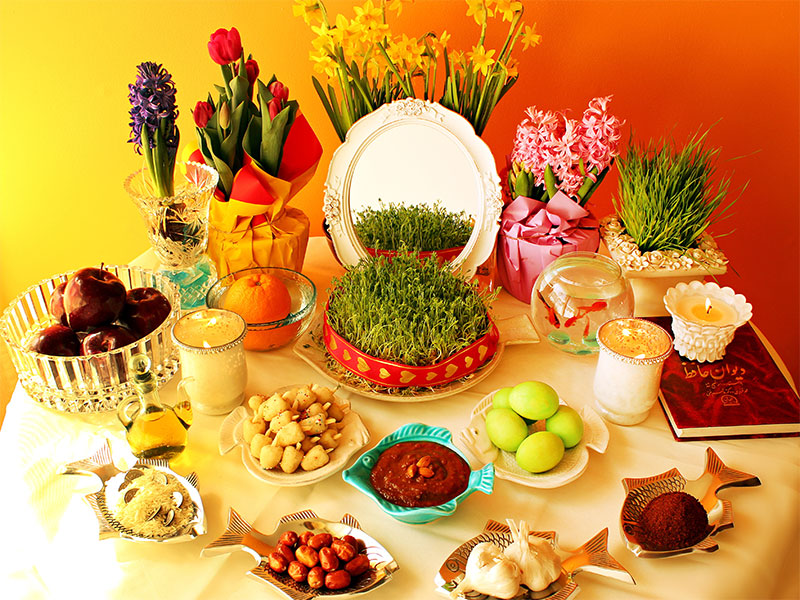
Setting “Sofreh Haft Seen” or Haft seen tabletop is an interesting custom of Nowruz.
Mehregan
Autumn starts with the month of Mehr (the seventh month of the year) in Iran, and its 16th day is called Mehregan, which is the celebration of light, friendship, kindness, and love in the Avestan calendar. Mehr means sun in Persian culture, which is said to be the eye of Mitra, the goddess of light. It is also Thanksgiving Day for Iranian farmers. In ancient times, Mehregan was harvest day, and some crops were gifted to the king. People spend this day visiting their loved ones, especially the ones that have been missed for a long time to enjoy the beauty of this vibrant-colored season together, and this celebration used to be among the most prominent Iranian festivals. One lovely tradition is throwing a handful of noghl (sugar plum) over one another’s heads before exchanging hugs and kisses. Mehregan festival is full of love, light, friendship, and kindness.
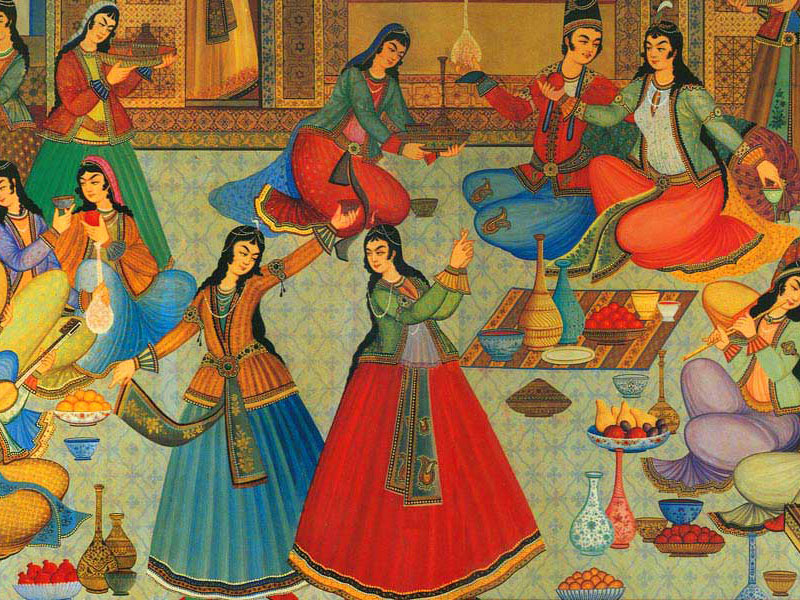
A painting on the celebration of Mehregan, a Thanksgiving Day for the Iranian farmers.
Shab-e-Yalda (Yalda Night)
Shab-e-Yalda (Yalda Night), also known as Shab-e Chelleh, is one of the most ancient Iranian festivals annually celebrated on December 21 by Iranians worldwide. It is the last night of autumn and the longest night of the year. Yalda means birth, referring to the birth of Mitra, the mythological goddess of light. Since days get longer and nights shorter in winter, Iranians celebrate the last night of autumn as the renewal of the sun and the victory of light over darkness. On Yalda night in Iran, people gather in groups of friends or relatives and usually at the home of grandparents or the elderly to pass the longest night of the year happily by eating nuts and fruits, reading Hafiz poems, making good wishes, and talking and laughing all together.
The Iranians celebrate this special night by eating nuts, watermelons, and pomegranates. Some believe that Pomegranate is a symbol of birth and its bright red seeds symbolize the glow of life. Reading poems from Divan-e-Hafiz is another fascinating tradition of Yalda Night. Every member of the family or a group of friends makes a wish and randomly opens the book. Then the eldest member of the family or friends reads the randomly selected poem loudly. Since the poem is believed to be the interpretation of the wish and the way it would come true, it is fun to interpret the poem and guess the wishes others make. So, autumn’s last and longest night passes happily, and winter’s first great day begins.

Yalda Night, one of the most ancient Iranian festivals annually celebrated on December 21.
Tasua and Ashura
The days of Tasua and Ashura are the 9th and 10th of Muharram (the first month of the Islamic calendar). Shia Muslims commemorate the battle of Karbala that occurred in 680 AD. The Muslim’ Prophet’s grandson” Hossein” and his 72 relatives and supporters died in this battle. Muharram rituals are an example of cultural-religious ceremonies among Shia Muslims. They are held annually in the form of a mass movement in Iran. People usually dress in black and rally in the street during Muharram in Iran. Some carry huge metal pieces decorated with flags and lead the crowd. Some beat their drums, some hit their backs with chains, and others accompany the mourning ones. Many families cook Iranian food that is called Nazri. Then, they distribute Nazri food or drinks among all people. Tourists can also participate in making food or distributing it.
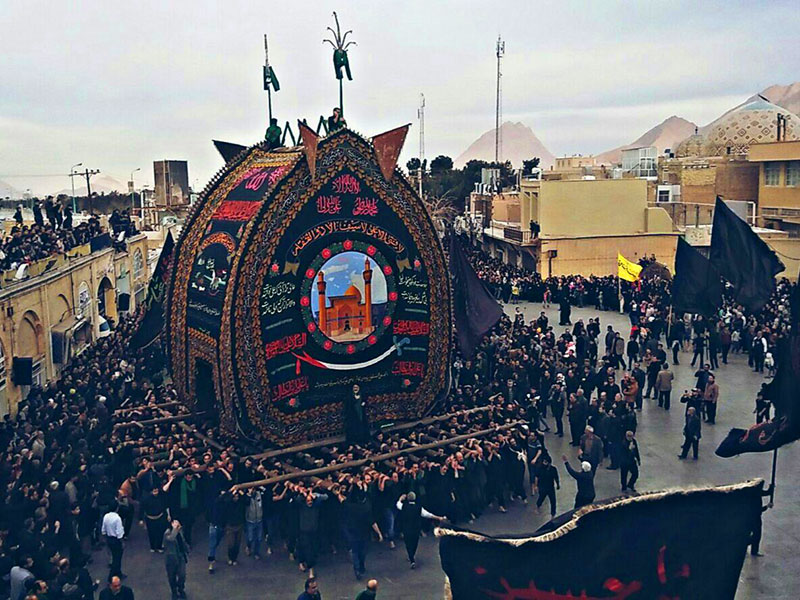
The Nakhl (palm tree) is a huge structure in the shape of a large leaf or the cypress tree which symbolizes the coffin of Imam Hossein and his martyr companions.
If you have decided to travel to Iran, get more information on Iran visa.
Zoroastrian Fire Temples in Iran: All You Need to Know
The fire temple or Atashkadeh is a place of worship for Zoroastrians. In the fire temples, followers of Zoroastrianism made fire and performed their religious ceremonies. Since fire is a symbol of truth and light for Zoroastrians, there is an ever burning fire in the middle of all fire temples. The fire is a sacred element for Zoroastrians and they revere fire in different forms. There are many Zoroastrian Fire Temples in Iran and they have great information about Zoroastrianism and its traditions. Travel to Iran to discover the Zoroastrian fire temples.
In Zoroastrianism, human life indicates a struggle between good and evil, truth and deceit, light and darkness. That is why fire is sacred and respected as the symbol of truth and honesty. Though Zoroastrianism has roots in the 6th BC, it entered recorded history in 5th BC. There are some inscriptions indicating that Achaemenid kings were the followers of Zoroaster. Since making a new fire had been difficult in ancient times, Zoroastrian communities developed fire temples with ever burning fires. The fire keepers were responsible for keeping the fire burning. They covered the fire carefully with its ashes so that they could remove them in the morning. In this way, people did not have to make fires separately and they could take fire from the fire temples. As a result, fire temples became the necessary part of each community and fire keeping became a crucial profession. Later, the fire temples developed and were called Atash Gah in Persian. Moreover, they believe that fire and water are the elements of ritual purity.
Fire as a symbol of truth is a sacred element for Zoroastrians
The documents indicate that Zoroastrians had no temples until the 5thcentury BC and the people used to pray at homes or on the top of the hills. The fire temples were finally used by Zoroastrian communities. There are Zoroastrian temples dating back to the pre-Sassanid period; however, the majority of fire temples were constructed in the Sassanian dynasty. Today, the oldest remains of a fire temple is located on Mount Khajeh in Sistan,Iran. It belongs to the 3rd or 4th century BC.
The early fire temples were constructed in the form of Chahar—Taqi. Chahar-Taqi (four arches) had four pillars above which there was a dome-like structure. In fact, they were the rudimentary form of elaborate domes of the Islamic period. In other words, the construction of Islamic domes had roots in the Iranian-Zoroastrian structure called Chahar-Taqi (also called Char-taghi). Therefore, the pre-Islamic construction of Chahar-Taqi dates back to the Parthian Empire and the Sassanid Empire (approximately 3rd century BC). One of the oldest Chahar-Taqi structures –though just the ruins of it exist- is located in Jahrom and it dates back to the Parthian era. They were simple and open, and used as fire temples by Zoroastrians, especially during different assemblies.
Although the history of Zoroastrianism dates back to centuries BC, the glorious days of it refers to the Sassanian period (3rd to 7th AD). During their governance, Zoroastrianism found a specific place and it was announced as the official religion by the Sassanid kings. Therefore, great fire temples were made in that time. The ruins of many temples belonging to the Sassanid dynasty have been found in different parts of Iran, especially in Fars and Kerman provinces. It is interesting to know that during the Sassanid dynasty, there were three highly significant fire temples in Iran: Azar Goshnasb, Azar Barzin Mehr or Azar Borzin Mehr, and Azar Faranbagh. Each of the fire temples belonged to a special society class and it was believed that Ohrmazd had created the three of them to protect the world. The fire temple of Azar Goshnasb belonged to kings and armies, the fire temple of Azar Franbagh belonged to the priests, and the fire temple of Azar Borzin Mehr belonged to the farmers.
Azar Franbagh Temple located in Fars province belonged to the priests
The characteristic feature of the Sassanid fire temples referred to their domed sanctuary where the fire-altar stood. The sanctuary had a square ground plan with pillars at corners to support the dome (the gombad or Gonbad in Persian). Moreover, brick, stone, and wood were the basic elements applied to build the temples in that period.
Azar Franbagh Temple, located in Fars province, belonged to the priests. It was one of the most important fire temples constructed in the Sassanid Era. Since it was close to Karian village, it was also known as Karian Fire Temple. Since the fires of other fire temples were provided by the fire brining in the three great temples of the Sassanid period, Azar Faranbagh was also used to supply the required fire of other temples. After the Muslim conquest of Persia, the fire burning within the fire temple was transferred to Yazd. Today, it is still burning in Yazd Fire Temple.
Azar Goshnasb is also one of the three greatest Zoroastrian fire temples located in West Azerbaijan close to Takab. In the Sassanid period, it belonged to the kings and they used to go there before crowning and they granted so many gifts there. However, the history of Azar Goshnasb might date back to the late Parthian period. The Zoroastrian fire temple of Azar Goshnasb is located on the archeological site of Takht-e-Soleyman inscribed on UNESCO’s World Heritage List.
Literally, Azar Goshnasb meant “the fire of warrior kings” and it acted like a fortified fortress surrounded by high walls and many gates. Moreover, Azargoshnasb was constructed around a volcanic lake on the top of the mountain. One of the specific features of Azar Goshnasb was the type of fire burning within it. Atash Bahram, as one of the most sacred fires among Zoroastrians had been burning in Azar Goshnasb for many years.
Fire temple of Azar Goshnasb is located in the archaeological site of Takht-e-Soleyman
In comparison with other ancient temples of Iran, the history of Azar Goshnasb is more clarified for two reasons. The first refers to its location in the North West of Iran close to the western frontier of the country. As a result, more foreign visitors noticed its greatness. The second refers to the importance of it for Sassanid kings as a sacred place to take an oath and ascend the throne. Ferdowsi, as a great Persian Poet, described the temple of Azar Goshnasb in his Epic of Kings (Shahnameh). Though it had been one of the famous sites of the ancient times of Iran, it faded away after the 12th century till it was rediscovered in the 19th century.
The fire temple of Azar Borzin Mehr belonged to farmers and it was also recognized as one of the three great temples in the Sassanid period. It is located on the Reyvand Mountain (Rivand) in the province of Khorasan. Azar Barzin Mehr was highly respected by Zoroastrians in the Parthian and Sassanid dynasties. The temple of Azar Borzin Mehr also had the structure of Chahar Taqi.
Zoroastrianism declined after the Muslim conquest of Persia in the 7th century. Today, the majority of Zoroastrians of Iran live in Yazd and some of them also live in cities such as Tehran and Isfahan. Therefore, one could find Zoroastrian fire temples in Tehran, Isfahan, and other cities of Iran; however, a majority of them are located in Yazd province. Therefore, a person who travels to Yazd could visit Yazd Atashkadeh as well as the village of Chak Chak in Ardakan County, as two important places for Zoroastrians.
Pir-e-Sabz Fire Temple
Yazd Fire Temple (Yazd Atashkadeh) is located in Yazd and it houses Atash Bahram. The building of the fire temple was made in 1934. Zoroastrians usually gather together in the Yazd Fire temple for different ceremonies. They must wear white or light colored clothes to enter the fire temple; however, tourists are allowed to enter the fire temple as an attraction located in Yazd without wearing light-colored clothes. The fire burning in Yazd temple is believed to have been burning since 470 AD.
The village of Chak Chak, known as Pir-e-Sabz, is also a pilgrimage place for Zoroastrians. It is located near Ardakan County in Yazd province. It includes a Fire Temple known as Pir-e-Sabz Fire Temple on the mountain that annually attracts many Zoroastrians in June to have a religious festival.
Are you planning to travel to Iran? Check out our Iran tours.




